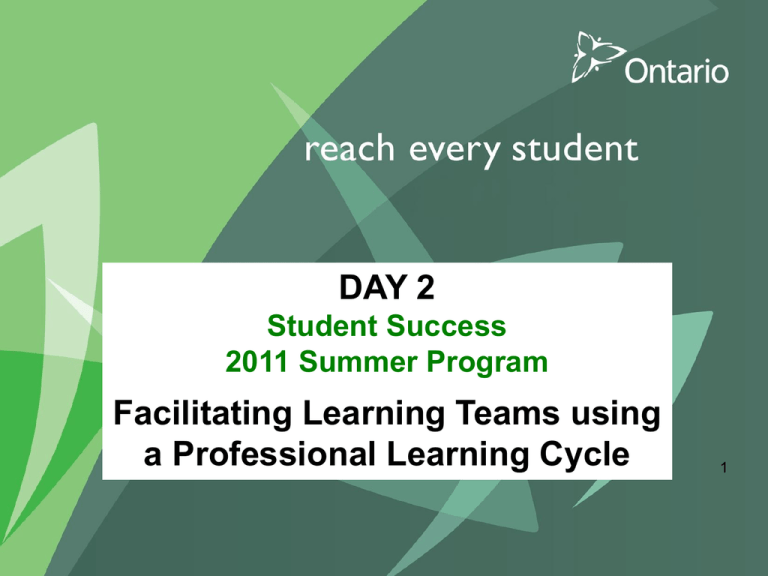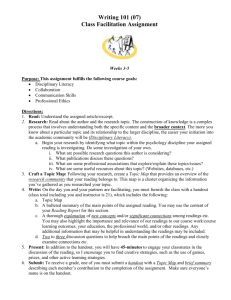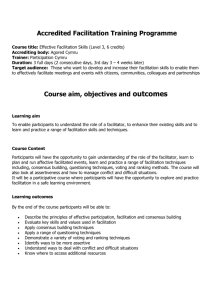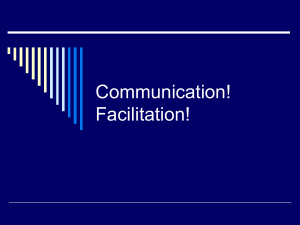Day2_2011SumFacSessi..
advertisement

PUT TITLE HERE Student Success DAY 2 Student Success 2011 Summer Program 2011 Summer Program Facilitating using NAME OFLearning YOURTeams MODULE a Professional Learning Cycle HERE 1 Agenda Day 1 Day 2 Minds On Group Profile (Wall Chart) Agenda, Purpose, Learning Goals and Context Walk About Opportunities and Challenges Minds On Action Facilitation Skills and Knowledge Base Facilitating the Professional Learning Cycle PLAN ACT Consolidation • Making Connections • • • Overview Three Heads Facilitation – Guided Viewing Action • Facilitating the Professional Learning Cycle OBSERVE REFLECT Consolidation Challenges, Assumptions and Next Steps 2 2 Learning Preferences Preference Prefers learning/demonstrating learning : Visual through diagrams, maps, charts… Aural/Auditory by hearing or speaking Reading/Writing through the written word Kinesthetic through experience, simulation, authentic videos… 3 Three Heads Like-preference groups: 1. Join with 2 others who have the same VARK preference(s) 2. Identify the top 3 or 4 key ideas in yesterday’s session 3. Figure out a way to share these with the large group using your common learning preference. 4 Stations: Supporting Implementation Option A: for sessions that include administrators who are supporting learning teams in their schools Select a topic of interest for viewing: • Building Capacity • Leadership • Facilitation View – with a focus on the Thinking Routine questions Share - with others at that viewing station Thinking Routine: ‘See-Think-Explore’ • What did you see? • What do you think? • What related ideas would you like to explore? 5 Stations: Guided Viewing - Facilitation Option B: for sessions with board and school level facilitators Select - a quote from Handout 11. View – with a focus on your chosen quote Share - with 2 or three others who selected the same quote Handout 11 6 Agenda Day 1 Day 2 Minds On Group Profile (Wall Chart) Agenda, Purpose, Learning Goals and Context Walk About Opportunities and Challenges Minds On • Overview • Three Heads • Facilitation – Guided Viewing Action Facilitation Skills and Knowledge Base Facilitating the Professional Learning Cycle PLAN ACT Consolidation • Making Connections Action • Facilitating the Professional Learning Cycle OBSERVE REFLECT Consolidation Challenges, Assumptions and Next Steps 7 7 Between ACT and OBSERVE What happens between the scheduled learning cycle meetings for ACT and OBSERVE? For example: • What is the facilitator doing? • What is the Administrator doing • What is the teacher doing? 8 OBSERVE Sharing instructional practice to monitor student learning and enhance educator learning 9 9 OBSERVE Video Prior to viewing, read the OBSERVE description in your notes organizer. 10 Guided Viewing - OBSERVE Jot your observations on the Guided Viewing handout based on the prompts provided. Handout 12 11 Student Work “One of the most powerful ways to ensure that any (learning team) stays focused – whether within or across schools – is by making sure that it is anchored by actual student work.” p. 76 Katz, Earl, Jaafar, 2009 (Corwin) “Having actual student work is at the center of the collaborative inquiry exercise. It creates the opportunity for evidence-driven, focused professional learning conversations.” p. 76 12 ACT – Four Corners OBSERVE – Four Corners/Carousel 1. Select a question of interest. 2. Join the corner group for that question. 3. Divide into groups of 4 or 5 at the corner – each group has a piece of chart paper. 4. Follow the facilitation instructions on the next slide. Handout 12 13 Using Facilitation Knowledge and Skills Identify a facilitator for your Corner group. The facilitator: • Helps the team select a (1) Standard and (2) a Move or Norm that they think will be important to the success of this activity • Ensures that the group understands the Standard/Move-Norm • Facilitates the group’s work through the Corner activity. 14 Ontario Ministry of Education, SS/L-18ITEB 2010 Differentiated Instruction Summer Program 14 ACT – Four Corners OBSERVE – Four Corners/Carousel Corner Groups of 5 or less 1. Brainstorm responses - on chart paper. 2. As a group, move to each of the other questions, examine and add or comment as needed. 3. Return to original Corner, examine comments of others, summarize and share key points. Handout 12 15 Collaborative Inquiry Continuum For a team on which you were a member or that you have facilitated, which ‘shared practice’ description best matches your team’s work? 16 HANDOUT 3 16 Facilitation Debrief 1. To what extent (rarely – sometimes – most of the time) was the group able to demonstrate the select: • Standard • Move or Norm 2. What challenges arose? As a group, decide on and share a way to address the challenge. 17 17 Instructional Strategies Check 1. What strategies were used to: • Focus viewing • Generate ideas • Stimulate thinking 2. How was instruction differentiated? 3. Note strategies used on the Strategy Bank handout. Handout 5 18 Making Connections Individually, take time to add notes and ideas to your Learning Cycle Organizer and to your Facilitation Mind Map 19 REFLECT Examining evidence to reflect on student and educator learning 20 20 Between OBSERVE and REFLECT What happens between the scheduled learning cycle meetings for OBSERVE and REFLECT? For example: • What is the facilitator doing? • What is the administrator doing • What is the teacher doing? 21 Guided Viewing: REFLECT Prior to viewing, read the REFLECT description in your notes organizer. 22 Guided Viewing: REFLECT Jot your observations on the Guided Viewing handout based on the prompts provided. Handout 13 •Analysis •Interpretation •Next Steps 23 After Viewing: REFLECT Table Groups • Discuss responses to the analysis, Interpretation and Next Steps prompts. • Share with the larger group. 24 Reflect: Discussion Questions Triads or Quads (Like-Role) Select a question of interest to discuss and be prepared to share a few points from your discussion with the larger group. 1. How would you help members of your learning team determine what they have learned and, based on student learning needs, their next steps for professional learning? 2. What would need to be in place to support a team to reflect in this way? 3. What would need to have occurred in the previous learning cycle phases for this type of reflection to occur. 25 25 Reflect Share a few points from your discussion with the larger group. 26 Collaborative Inquiry Continuum For a team on which you were a member or that you have facilitated, which ‘Individual and Group Reflection’ description best matches your team’s work? HANDOUT 3 27 27 Facilitation Your group had no formal facilitator: 1. What facilitative standards, skills, and ways of working together did your group collectively demonstrate? 2. In what ways, if any, might a facilitator have contributed to the functioning of the group? 28 28 Instructional Strategies Check 1. What strategies were used to: • Focus viewing • Stimulate thinking • Foster engagement 2. How was instruction differentiated? 3. Note strategies used on the Strategy Bank handout Handout 5 29 Making Connections Individually, take time to add notes and ideas to your Learning Cycle Organizer and to your Facilitation Mind Map 30 Agenda Day 1 Day 2 Minds On Group Profile (Wall Chart) Agenda, Purpose, Learning Goals and Context Walk About Opportunities and Challenges Minds On • Overview • Three Heads • Facilitation – Guided Viewing Action Facilitation Skills and Knowledge Base Facilitating the Professional Learning Cycle PLAN ACT Consolidation • Making Connections Action • Facilitating the Professional Learning Cycle OBSERVE REFLECT Consolidation Challenges, Assumptions and Next Steps 31 31 Consolidation - Challenges • Examine your session notes and update the Challenge board. • As a full group, sort and classify the challenges. • Create groups based on a category of interest. 32 32 Using Facilitation Knowledge and Skills Identify a facilitator for your interest group. The facilitator assists the group with: • Standards 1 and 2 and • using skills such as pausing, paraphrasing and inquiring. 33 Ontario Ministry of Education, SS/L-18ITEB 2010 Differentiated Instruction Summer Program 33 Assumptions and Next Steps 1. Identify, and post on chart paper, any assumptions related to the category. 2. Clarify /analyse the assumptions. (e.g., supporting evidence? always the case? challenges within the challenge?) 3. Determine whether the challenge can be addressed through facilitation. 4. What next steps can be taken to address the challenge? 34 Challenges Share a few points from your discussion with the larger group… inviting input as needed. 35 Facilitation Debrief 1. Why are skills such as pausing, paraphrasing and inquiring important to discussions? 2. To what extent did the group adhere to Standards 1 and 2? 36 36 Top Ten List 1. Examine notes, Mind Map and Strategy Bank. 2. As a Table Group, develop a Top Ten list of ideas and strategies that will be the most useful in facilitation work. 3. Share the top three with the large group. 37 anne.clifton@ontario.ca karen.greenham@ontario.ca linda.staudt@ontario.ca shawna.eby@ontario.ca jane.ashley@ontario.ca 38 38







